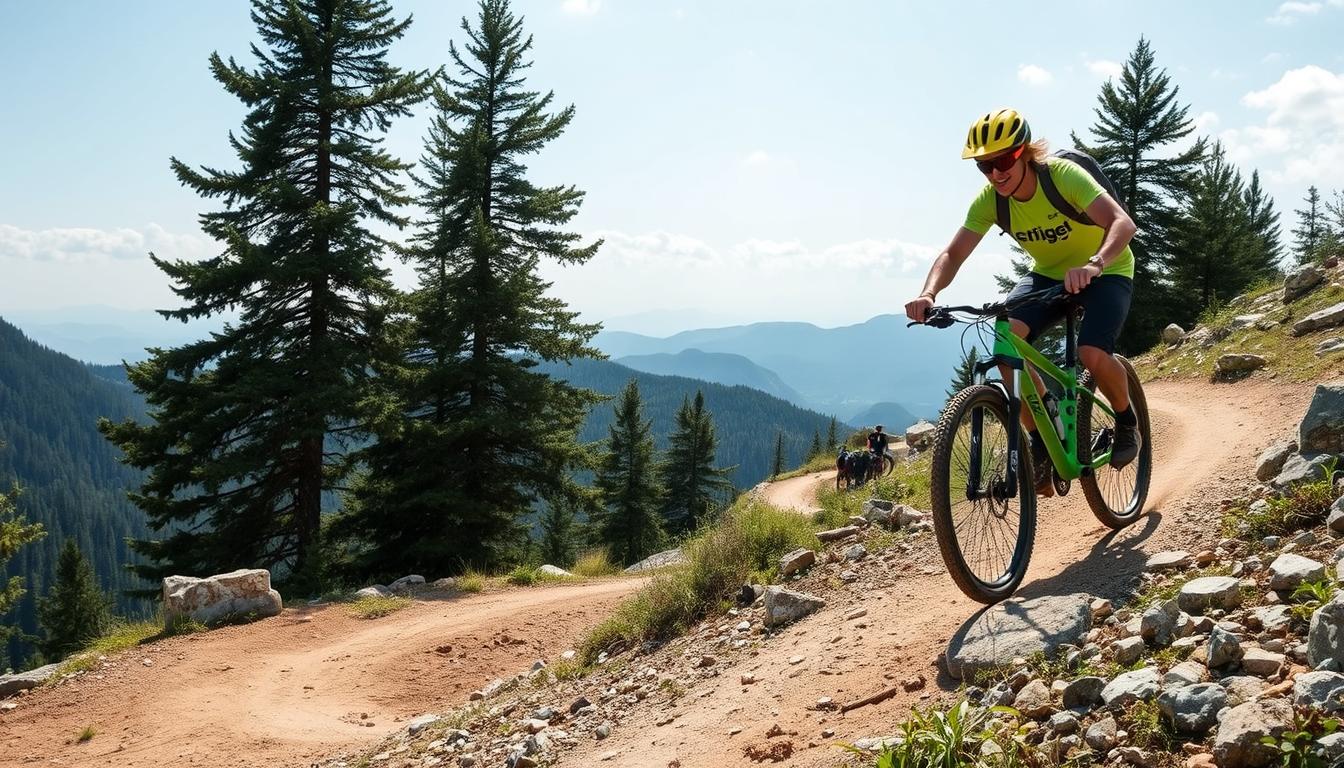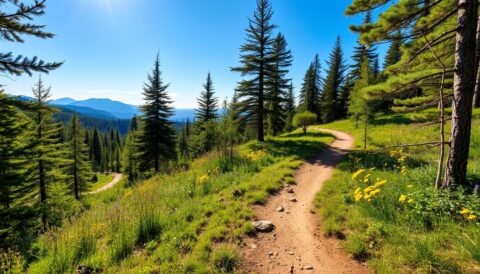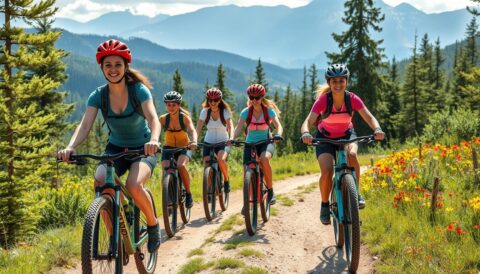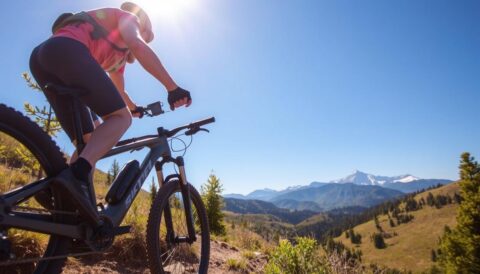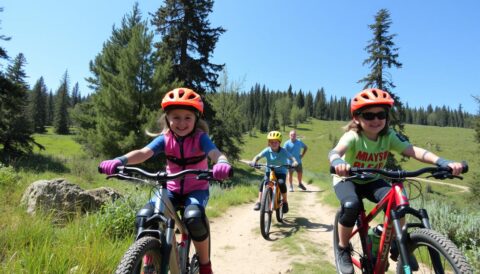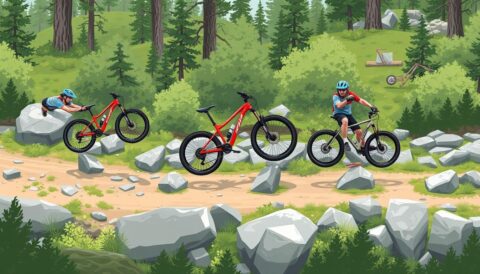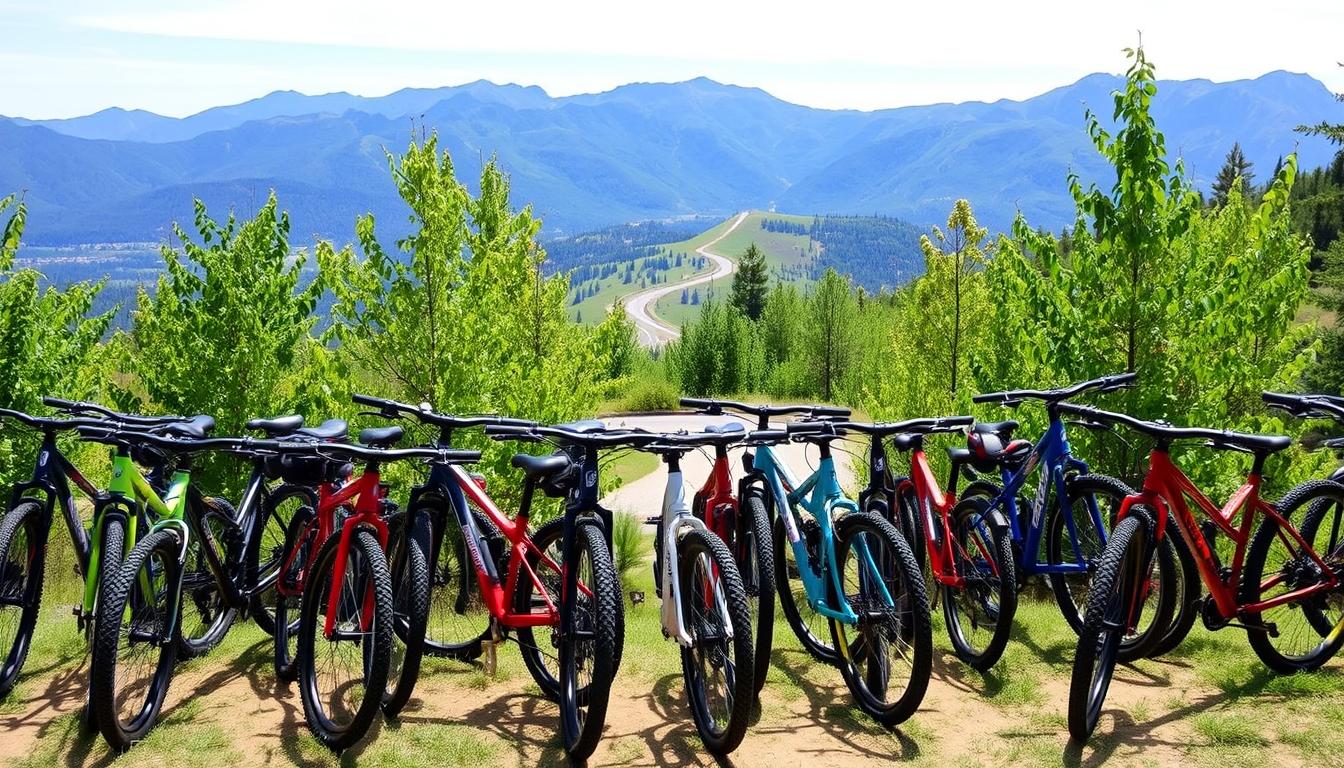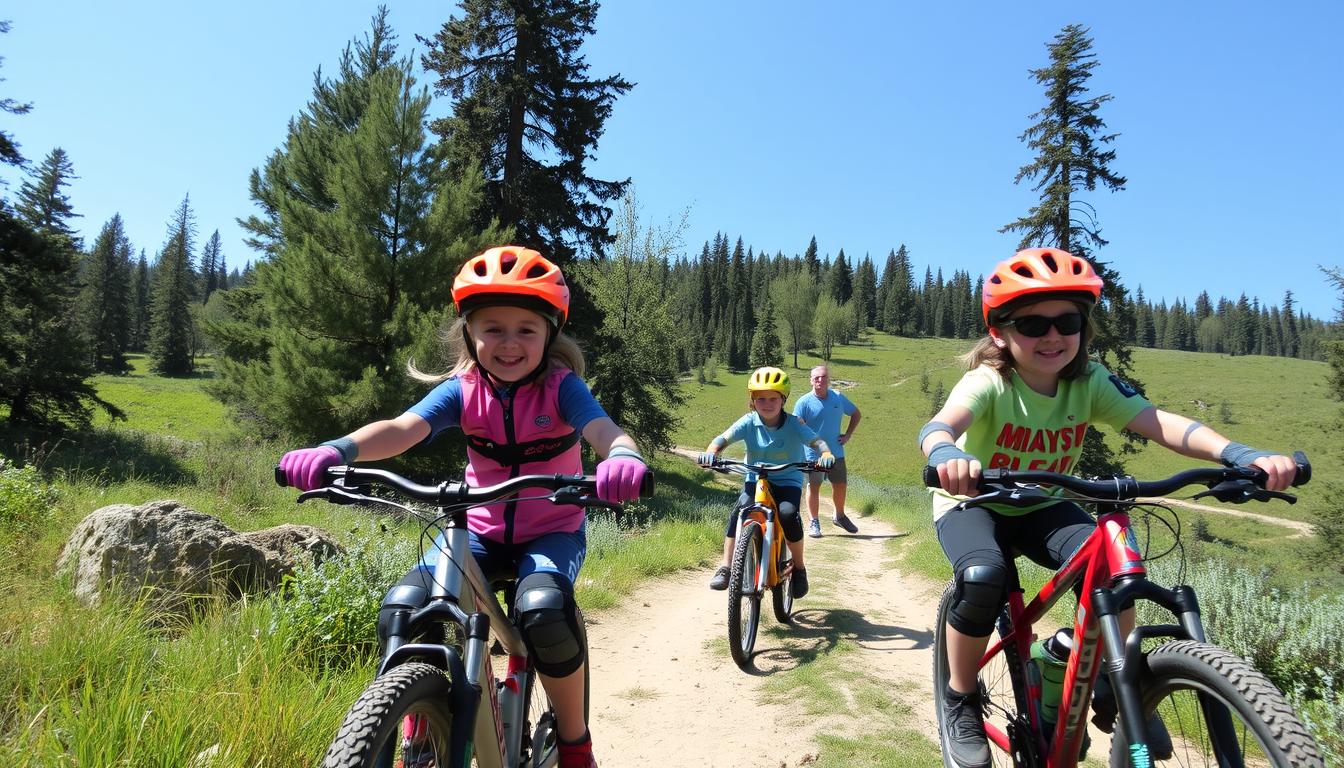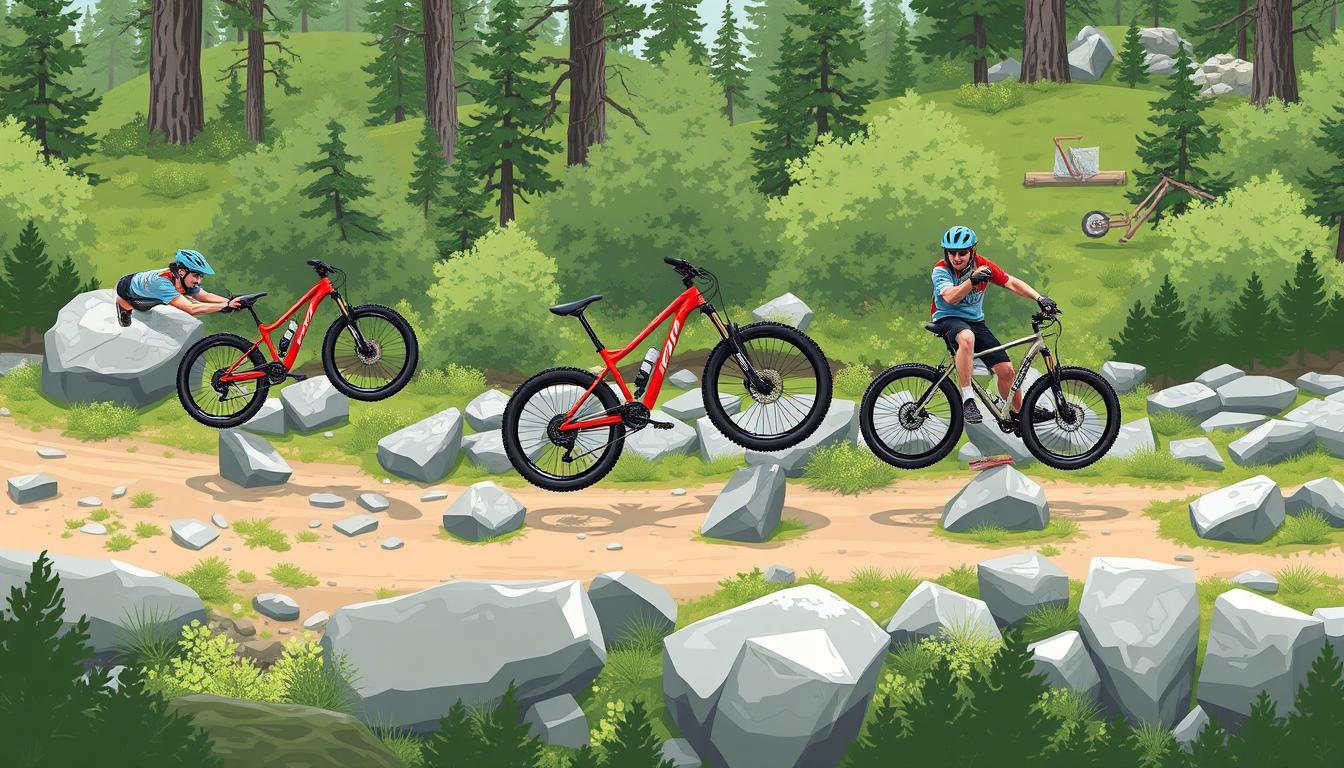Mountain biking thrills both body and mind. For newcomers, it can feel daunting with many potential pitfalls. The sport presents a steep learning curve for those eager to master it1.
Common errors can greatly affect a new rider’s experience. Over 50% of beginners struggle by focusing on obstacles rather than their desired path. This significantly increases accident risks1.
Data shows 80% of novice mountain bikers tense up whilst riding. This severely hampers their ability to navigate trails effectively1.
Grasping these beginner mistakes is key to building confidence and skill. About 70% of riders report discomfort due to poor technique1.
Successful mountain biking needs more than just physical strength. It requires mental preparation, technical know-how, and a learning mindset.
By tackling common errors early, riders can turn intimidating first tries into exciting adventures. This approach helps transform challenges into enjoyable experiences on the trails.
Choosing the Wrong Bike and Equipment
The right mountain bike is vital for a great ride. Many novices make mistakes when picking their first bike. This can affect their performance and safety.
About 60-70% of new cyclists buy bikes without knowing their needs. They also don’t understand the differences between bike types2.
Understanding Bike Types and Components
Choosing a mountain bike needs careful thought about riding style and terrain. Different bikes suit specific trail conditions:
- Cross-country bikes for long-distance rides
- Trail bikes for mixed terrain
- Downhill bikes for steep, technical descents
Essential Safety Gear Selection
Safety is crucial in mountain biking. Investing in proper mountain biking safety gear can greatly reduce injury risks. Helmets are vital – they can cut head injury risks by 85%2.
Key protective gear includes:
- Helmet
- Elbow pads
- Knee pads
- Gloves
Proper Bike Sizing and Fit
A good bike fit is key for comfort and performance. Poor bike fit can cause discomfort for nearly 70% of cyclists. This can lead to muscle strains and injuries2.
Experts suggest seeing a professional bike fitter for the best adjustments2.
Remember: Your bike should feel like an extension of your body, not a burden.
Choose your mountain bike carefully and invest in safety gear. Ensure a proper bike fit too. This will set you up for an amazing riding experience.
Common Beginner Mountain Biking Mistakes
Mountain biking challenges riders physically and mentally. Mastering techniques requires overcoming common pitfalls that hinder progress and safety on challenging trails.
Beginners often struggle with crucial aspects of mountain biking. Proper bike handling skills are essential for navigating diverse terrains. These skills help avoid potential accidents on the trails.
Looking Beyond the Obstacles
A key mountain biking technique is focusing on the trail ahead, not obstacles. Riders fixating on hazards are more likely to encounter them3. Look where you want to go.
Maintain a forward gaze to guide your bike naturally. This approach helps you navigate the trail more smoothly.
Maintaining Correct Body Position
Proper body positioning is critical for control and safety. 30% of beginner riders experience falls due to poor technique4. Correct positioning can prevent many challenges.
Riders should focus on:
- Keeping a relaxed, centred stance
- Distributing weight effectively
- Maintaining flexibility in arms and legs
Trail Etiquette Essentials
Understanding trail etiquette is crucial for responsible mountain biking. Respect for other trail users and the environment shows true skill.
| Trail Rule | Description |
|---|---|
| Right of Way | Yield to uphill riders and hikers |
| Trail Preservation | Stay on marked paths, avoid creating new trails |
| Group Riding | Communicate and ride in a single file when necessary |
“The mark of a true mountain biker is not just skill, but respect for the trail and fellow riders.”
Focus on these fundamental techniques and trail etiquette to develop confidence. Improve your bike handling skills for a safer, more enjoyable ride3.
Proper Tyre Pressure and Suspension Setup
Mountain bike tyre pressure and suspension setup greatly affect bike performance. These adjustments can turn an uncomfortable ride into an extraordinary one. Many riders overlook these crucial elements, but they’re key to top trail performance.
Mountain bike tyre pressure needs careful thought. Pressures usually range from 25 to 35 psi. The rear wheel often needs slightly higher pressure due to weight distribution.
Finding the right balance is crucial. Too high pressure reduces traction. Too low pressure risks damaging the rim.
- Ideal rear tyre pressure: Slightly higher than front
- Recommended pressure range: 25-35 psi
- Check pressure before each ride
Suspension setup is just as vital for bike performance. Proper SAG should be 15-35% of total suspension travel. Riders must adjust rebound settings with care.
Slower settings feel good on easy rides. However, they can cause problems on tricky terrain.
“Your bike’s setup is the difference between surviving and thriving on the trail.”
Pro mountain bikers know balanced damping settings are crucial. Unbalanced setups can upset weight distribution. This negatively affects handling and overall ride quality5.
Safety Gear and Protection Essentials
Mountain biking safety starts with proper protective gear. The right equipment minimises injury risks and boosts confidence on tough trails6.
Helmet Selection and Critical Fit
A well-chosen helmet is vital for mountain biking safety. Most helmets use EPS foam, with prices varying based on features6.
Helmets with Mips technology offer better protection. They disperse rotational energy during potential crashes6.
- Ensure proper helmet fit
- Check for rotational impact systems
- Prioritise activity-specific designs7
Body Protection Equipment
Body protection goes beyond helmets. Knee pads are crucial for beginners, providing confidence and trail protection6.
Full-finger gloves offer better hand protection than half-finger options6.
| Protective Item | Protection Level |
|---|---|
| Knee Pads | High |
| Full-Finger Gloves | Moderate to High |
| Protective Eyewear | Essential6 |
Essential Safety Accessories
Bikers should carry a multi-tool with six to eight pieces. This allows for on-the-spot repairs6.
Protective eyewear is crucial. It prevents potential eye injuries from environmental factors6.
Safety isn’t expensive, it’s priceless – especially in mountain biking.
Quality protective gear prevents injuries and boosts confidence. It ensures you enjoy your ride safely.
Trail Navigation and Riding Techniques
Mastering mountain bike navigation requires understanding terrain and developing essential riding techniques. Trail reading is a critical skill for mountain bikers. It transforms beginners into confident riders8.
Successful mountain bike navigation begins with grasping your environment. Riders should focus on key techniques for better performance. These include maintaining stability and reducing fall risks.
- Maintaining a horizontal pedal position for stability8
- Keeping eyes focused ahead to reduce fall risks8
- Shifting weight appropriately through challenging terrain8
The secret to great trail reading is anticipating the path ahead and choosing the most efficient line.
Mountain bike riding involves dynamic skill development. Riders can boost their abilities by practising bunny hops, drops, and track stands9. The sport demands bursts of high-intensity effort during rides.
Typically, riders perform 6-10 maximum-effort pedal strokes throughout their journey9. This high-intensity approach helps improve overall performance and endurance.
| Skill Level | Key Navigation Techniques |
|---|---|
| Beginner | Trail marker interpretation, basic line selection |
| Intermediate | Advanced terrain reading, efficient cornering |
| Advanced | Complex obstacle navigation, speed management |
Learning from experienced riders can quickly improve your skills9. Many enthusiasts suggest riding with faster peers to enhance techniques. This approach helps build confidence and improves overall riding ability9.
Physical Preparation and Endurance Management
Mountain biking requires top-notch fitness and smart planning. Riders need a balanced approach to fitness, blending strength, stamina, and mental toughness. Grasping the physical demands is key for newcomers aiming to shine in this thrilling sport.
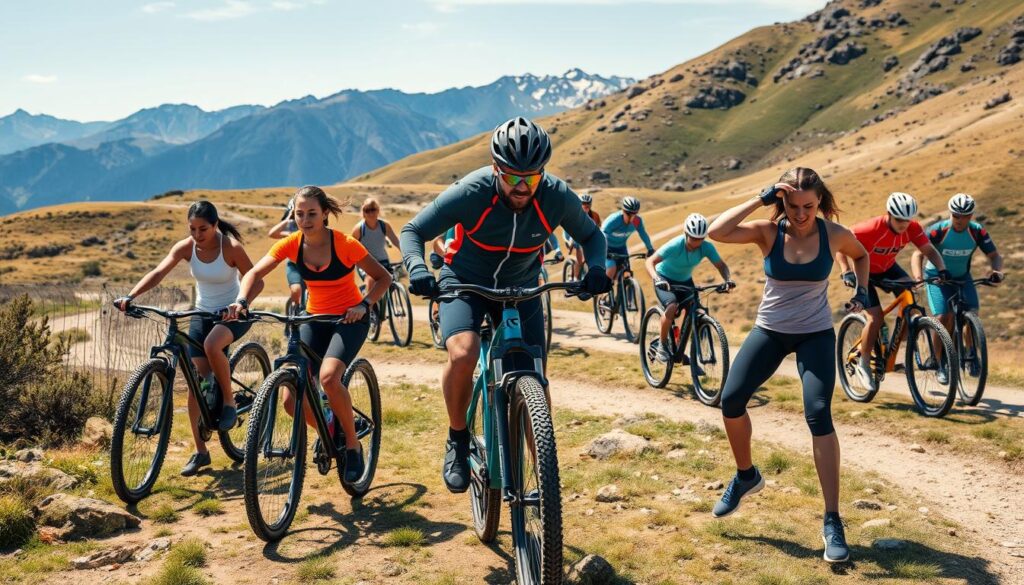
Building Proper Fitness Levels
Boosting mountain biking fitness calls for a focused strategy. Cyclists should aim for steady progress, following structured plans that ramp up over 8-12 weeks.
Key training areas include:
- Cardiovascular endurance training
- Strength conditioning for core and leg muscles
- Flexibility and mobility exercises
Nutrition and Hydration Strategies
Effective endurance training for cyclists needs careful meal planning. Sandra Walter, a pro athlete, suggests smart eating to support intense workouts10.
| Nutrition Stage | Recommended Strategies |
|---|---|
| Pre-Ride | Complex carbohydrates, lean proteins |
| During Ride | Energy bars, dried fruits, hydration |
| Post-Ride Recovery | Protein-rich meals, electrolyte replacement |
Recovery Techniques
Mental toughness and proper rest are vital for cyclists’ nutrition. Athletes should use structured recovery methods to avoid burnout and lower injury risks11.
Rest is not weakness—it’s a critical component of performance improvement.
Mental toughness and adaptive training methods are key to sustained mountain biking performance10.
Bike Maintenance and Care Fundamentals
Mountain bike maintenance is vital for keeping your ride in top shape. Proper care extends your bicycle’s life and boosts performance12. Regular upkeep protects your investment and ensures safe, fun rides.
Drivetrain hygiene is crucial for bicycle care. Focus on the chain and moving parts13. Here are key maintenance practices for mountain bikers:
- Check tire pressure before every ride13
- Clean and lubricate the chain regularly
- Inspect brake pads for wear12
- Carry essential tools on every ride13:
- Multitool with chain breaker
- Mini pump or CO2 inflator
- Patch kit or spare tube
Pro Tip: A clean bike is a happy bike! Approximately 90% of bike maintenance can be done with simple household items12.
Maintenance frequency is important for mountain bikes. Tubeless tire sealant should be refreshed every three months13. Regular checks can prevent up to 25% of potential repair issues13.
These bike care tips will keep your mountain bike reliable and efficient. Consistent maintenance is the key to lasting cycling enjoyment. Your bike will be ready for your next adventure.
Conclusion
Mountain biking blends physical challenge with natural exploration. Beginner cyclists must grasp key tips for skill development and safety1415. Learning from mistakes helps novices become confident trail riders.
Skill improvement needs patience and practice. Falls and learning curves are part of mountain biking progression. A positive mindset turns each experience into a chance to boost technical abilities.
Safety is crucial in mountain biking. Proper gear, trail etiquette, and bike maintenance reduce risks141516. Enjoy the ride while respecting your limits and the environment.
Mountain biking’s core is pure enjoyment. Each trail offers a unique experience in nature. Stay curious and committed to learning on your two-wheeled adventure.
FAQ
What equipment do I need as a beginner mountain biker?
Beginners need a suitable mountain bike and a well-fitted helmet. Protective gear like knee pads and gloves are essential. You’ll also want cycling clothes, a water bottle, and a repair kit.
Choose a bike that fits your size and matches the local terrain. Comfortable cycling shoes complete your basic equipment list.
How do I choose the right mountain bike?
Think about your riding style, local terrain, and budget when choosing a bike. Beginners often do well with a hardtail mountain bike. It’s more affordable and versatile.
Look for a bike with the right frame size and good suspension. Visit a local bike shop for professional fitting and advice.
What are the most common mistakes beginners make in mountain biking?
Beginners often look at obstacles instead of the trail ahead. Incorrect body positioning and improper tyre pressure are also common errors.
Neglecting bike maintenance and not wearing proper safety gear can be risky. Learning basic trail etiquette is crucial for a safe ride.
How important is bike maintenance for mountain biking?
Bike maintenance is vital for safety, performance, and longevity of your mountain bike. Regular tasks include cleaning the drivetrain and checking tyre pressure.
Lubricating moving parts and inspecting brake pads are also important. Perform safety checks before each ride to prevent mechanical failures.
What safety gear is essential for mountain biking?
A well-fitted helmet and protective eyewear are must-haves. Knee pads, elbow pads, and gloves offer extra protection.
Padded cycling shorts and proper shoes enhance comfort. Carry a first aid kit and emergency communication device for safety.
How can I improve my mountain biking skills?
Practice proper body positioning and focus on the trail ahead. Learn basic techniques like braking and cornering. Understand trail markers and build your fitness.
Start on easier trails and gradually progress to more challenging terrain. Consider taking skills workshops to boost your confidence.
What should I know about tyre pressure for mountain biking?
Tyre pressure affects performance and comfort. Lower pressure gives better traction on rough terrain. Higher pressure reduces rolling resistance on smooth trails.
Beginners should start with 25-30 PSI. Adjust based on your bike, weight, and terrain for optimal riding experience.
How do I prepare physically for mountain biking?
Build cardiovascular endurance through cycling, running, or swimming. Include strength training for legs, core, and upper body.
Practice nutrition and hydration strategies for long rides. Do warm-up exercises and allow proper recovery time between rides.
What trail etiquette should I follow?
Follow right-of-way rules and stay on designated trails. Yield to other trail users and avoid skidding.
Don’t litter and respect wildlife. Ride within your skill level. Be courteous to other riders, hikers, and the environment.
Source Links
- 5 Rookie Mountain Bike Mistakes To Avoid
- Know the Common Beginner Cycling Mistakes To Avoid
- 10 Mistakes We Made When We Started Mountain Biking
- Flow’s Top Tips for Beginner Mountain Bikers | Progress your MTB skills and tackle new challenges
- mountain bike set up mistakes to avoid – SAGLY – Mountain Bike Setting Made Easy
- Beginner mountain bike gear – everything you need to know
- Common Mistakes Beginners Should Avoid – The Gym Bike Expert
- 8 tips on how to start mountain biking
- Best ways to get started mountain biking?
- How to Keep Improving, No Matter What | Liv Cycling
- Is Mountain Biking Hard For Beginners?
- If You’re New to Riding, Knowing These Basic Maintenance Skills Will Boost Your Confidence for the Road
- Every Cyclist Should Know These 101 Bike Maintenance Tips
- Six Do’s and Don’ts of Your First Mountain Bike Ride
- Things NOT To Do When You’re New To Mountain Biking
- Mountain Biking Tips for Beginners
